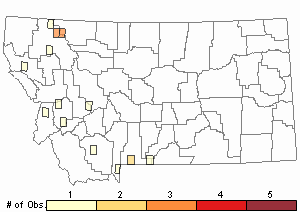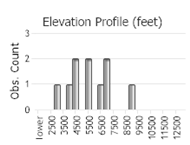View in other NatureServe Network Field Guides
NatureServe
Montana
Utah
Wyoming
Idaho
Wisconsin
British Columbia
South Carolina
Yukon
California
New York
A Schistidium Moss - Schistidium rivulare
General Description
Plants: Acrocarpous (Vitt 1988), growing in loose to dense and frequently large mats or clumps of erect shoots, deep or olive green, sometimes brown (FNA 2007) to blackish (Vitt 1988), occasionally tipped with a somewhat limey green color. Stems 1.2 -18 cm in height, possessing a central strand (FNA 2007).
Leaves: Overlapping a little, frequently a little twisted, bent, and curved toward the stem or sometimes toward the side when dry, 1.2-3.2 mm in length, lance-shaped with ovate tendencies (FNA 2007) or widely ovate, tapering to a muticous (Crum & Anderson et al., 1981), acute, or wider-angled leaf tip (FNA 2007), the tip not hyaline (Vitt 1988), the leaf strongly longitudinally-folded along the mid-leaf above, the fold continuing to cupped below; leaf edges finely toothed above or smooth, curved back and downward from near the base to a little above the proximal half, sometimes to the leaf tip, rarely flat; costa extending to or to near the leaf tip (FNA 2007).
Leaf Cells: Lamina 1 cell-layer thick with areas or lines of 2 cell-layers above; upper laminal cells similar in length and width or sometimes short and oblong, a little wavy, smooth; lower laminal cells usually square; leaf edges of 1 or 2 (seldom 3) cell-layers (FNA 2007).
Phenology
Fruit ripens the last part of spring into the first part of summer (FNA 2007).
Diagnostic Characteristics
Schistidium agassizii, which also grows along streams, can be distinguished by its less-strongly ovate leaves with plane rather than recurved margins, and weakly rather than strongly keeled upper leaf (FNA 2007).
Range Comments
AK to NL and NS, s to CA, AZ, NM, OK, MO, MS, TN and NC (FNA 2007). Known in Montana from Cascade, Flathead, Glacier, Granite, Lewis and Clark, and Park Counties (Elliott & Pipp, 2016).
Observations in Montana Natural Heritage Program Database
Number of Observations: 18
(Click on the following maps and charts to see full sized version)
Map Help and Descriptions
Relative Density

Recency



 (Observations spanning multiple months or years are excluded from time charts)
(Observations spanning multiple months or years are excluded from time charts)
Habitat
Stones, wet or dry, along rivers, streams, and lakes, occasionally on stones that are periodically wetted (FNA 2007), often calcicolous (Vitt 1988). Elevation: 0-15,090 feet (FNA 2007).
Ecology
The plants of this species enjoy inhabiting rocks which receive splashing from running water and are sometimes inundated for periods. When the water level drops, the plants may dry out thoroughly in their periodically xeric habitat (Vitt 1988).
Reproductive Characteristics
Autoicous (FNA 2007). Perichaetial bracts larger than stem leaves, 3.5-4 mm in length. Seta less than 1 mm in height (Crum & Anderson et al., 1981). Capsule immersed (Vitt 1988), 0.6-1.1 mm in length, russet or green with yellow tones, seldom very dark, shaped somewhat like a cup, sometimes with the mouth flaring; peristome deep red and covered with papillae. Calyptra not completely shielding the capsule (FNA 2007).
Stewardship Responsibility
References
- Literature Cited AboveLegend:
 View Online Publication
View Online Publication Crum, H.A. and L.E. Anderson. 1981. Mosses of Eastern North America. 2 volumes. Columbia University Press, New York. 1328 pp.
Crum, H.A. and L.E. Anderson. 1981. Mosses of Eastern North America. 2 volumes. Columbia University Press, New York. 1328 pp. Elliott, J.C. and A.K. Pipp. 2018. A Checklist of Montana Mosses (1880-2018). Updated 3 January, 2020. Montana Natural Heritage Program, Helena, Montana. 73 pp.
Elliott, J.C. and A.K. Pipp. 2018. A Checklist of Montana Mosses (1880-2018). Updated 3 January, 2020. Montana Natural Heritage Program, Helena, Montana. 73 pp. Flora of North America Editorial Committee, eds. 2007. Flora of North America North of Mexico. Volume 27. Bryophytes: Mosses, Part 1. Oxford University Press, Inc., NY. xxi + 713 pp.
Flora of North America Editorial Committee, eds. 2007. Flora of North America North of Mexico. Volume 27. Bryophytes: Mosses, Part 1. Oxford University Press, Inc., NY. xxi + 713 pp. Vitt, D. J. Marsh, and R. Bovey. 1988. Mosses, Lichens & Ferns of Northwest North America. Seattle, WA: University of Washington Press. 296 p.
Vitt, D. J. Marsh, and R. Bovey. 1988. Mosses, Lichens & Ferns of Northwest North America. Seattle, WA: University of Washington Press. 296 p.
- Additional ReferencesLegend:
 View Online Publication
View Online Publication
Do you know of a citation we're missing? Elliot, J. C. 1993. Second checklist of Montana mosses. Unpublished report. U.S. Forest Service, Region 1. Missoula, MT. 45 pp.
Elliot, J. C. 1993. Second checklist of Montana mosses. Unpublished report. U.S. Forest Service, Region 1. Missoula, MT. 45 pp. Lawton, E. 1971. Keys for the Identification of the Mosses on the Pacific Northwest. Reprinted from 'Moss Flora of the Pacific Northwest'. Published as Supplement No. 2 of the Journal of the Hattori Botanical Laboratory. Nichinan, Miyazaki, Japan. 66 pp.
Lawton, E. 1971. Keys for the Identification of the Mosses on the Pacific Northwest. Reprinted from 'Moss Flora of the Pacific Northwest'. Published as Supplement No. 2 of the Journal of the Hattori Botanical Laboratory. Nichinan, Miyazaki, Japan. 66 pp. Lawton, E. 1971. Moss Flora of the Pacific Northwest. Hattori Botanical Laboratory. Japan: Yamabuki-cho, Shinjuku-ku, Tokyo. 362 pages plus appendices.
Lawton, E. 1971. Moss Flora of the Pacific Northwest. Hattori Botanical Laboratory. Japan: Yamabuki-cho, Shinjuku-ku, Tokyo. 362 pages plus appendices. Malcolm, B., N. Malcolm, J. Shevock, and D. Norris. 2009. California Mosses. Nelson, New Zealand: Micro-Optics Press. 430 pp.
Malcolm, B., N. Malcolm, J. Shevock, and D. Norris. 2009. California Mosses. Nelson, New Zealand: Micro-Optics Press. 430 pp.
- Web Search Engines for Articles on "A Schistidium Moss"





